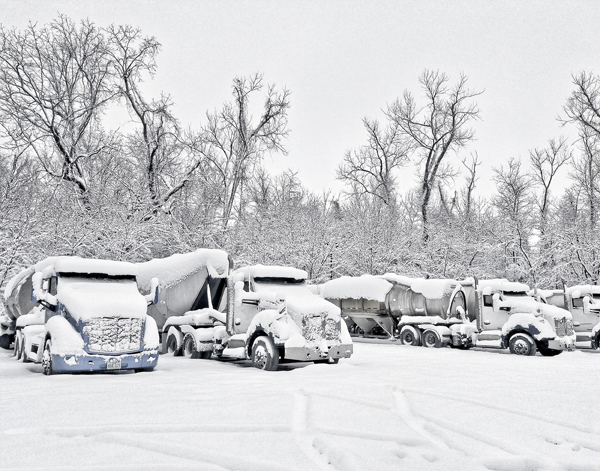

Fall is the perfect time of year to prepare your rigs for the next few months on the road. Winterizing your truck is an essential best practice for preventing traffic accidents and ensuring load transportation safety during the most hazardous time of the year. Prepare your truck fleet or personal truck for the cold, snow, and ice that’s quickly approaching.
Get ready for winter driving conditions with these top six tips for truck winterization:
Tip 1: Prepare Fuel and Brakes
During the summer, condensation and humidity create water in the fuel tank. Prep your fuel by adding water/gas separators for maximum engine performance. Check water separators, and drain excess to prevent freezing. Add anti-gel conditioners to your fuel to reach the ideal fuel mix ratio for your engine. Replace or clean your fuel filter, which can easily become gel-clogged in cold temperatures.
Ensure water is removed from air brakes, which can cause freeze-ups, by replacing or double checking your air dryers and adding brake conditioner. Don’t forget to check your cooling systems! Connective hoses and belts can easily leak or crack during winter months. Cooling system problems in the winter can cause complete engine failure and the need for replacement.
Tip 2: Check Tire Chains
Depending on your truck company and state regulations, truck winter tire chains may or may not have to be carried onboard. If you’re approaching winter driving in northern states or will be driving trucks in states with high elevations, prepare by reviewing your truck company’s winter driving policies (such as parking conditions, using chain banks, or carrying chains onboard).
If you do carry tire chains on board, check that chains are in excellent condition and the proper size/style for the rig. Many chains can rust or become damaged if carried year-round. Ensure drivers have proper tire chain installation training, and remind drivers to stop shortly after installing to re-tighten and secure chain positions. Chain tighteners help you achieve the correct tautness for tires. Tires should be replaced based on tread conditions and usually in advance of winter. Double check tire pressure throughout the winter months for correct inflation as well.
Tip 3: Test the Battery (and Jumper Cables)
Before the cold weather hits, test your truck’s battery. Just as with gasoline engines, diesel engines need batteries with enough amps to turn the engine over. Cold conditions can hinder or drain battery strength. Replace your battery if it’s close to the end of its life—most truck batteries usually last two to three years.
If your battery is strong and has a good life left, double check that connections to terminals are tight, and that the battery is securely mounted. While we’re discussing batteries, check your truck’s jumper cables to ensure they can hold and share a charge. The worst time to find out that your jumper cables don’t work is when your battery is dead, too!
Tip 4: Replace Wiper Blades and Check Windshield
The smallest things can keep you safe when driving. Replace your windshield wiper blades before winter, especially if you have worn or torn ends. Your truck windshield is wide and prone to damage by debris and drastic weather conditions throughout the year. Proper windshield defrosting and cleaning helps prevent windshield damage.
Constant inspection for chips and cracks should be a standard practice for drivers, and repair kits are available for minor flaws. Chips often turn into cracks in cold weather, and cracks can extend and impair vision. Repairing windshield chips before they expand can save costly replacement or repairs. Also, remember to replace your windshield wiper fluid with a non-freeze variety before winter months.
Tip 5: Install an Engine Heater
Consider installing a heater to your truck’s engine block to help heat your engine, oil, and battery. Engine heaters keep trucks warm and ready to start in cold temperatures. Heaters also prevent the need for truck idling (to keep engine or interiors warm), reduce your fuel consumption, and lessen your truck’s pollution. Heaters reduce wear on engine life, and reduce cold starts that can damage batteries and starters. In addition, an engine heater lets the cooling system reach the correct temperature more quickly.
Tip 6: Ensure Lights Are Properly Working
A traditional truck maintenance item is to double check all the lights on your vehicle. Replace bulbs and light units that show wear or are weak in brightness. During the winter months, lights can mean the difference between a clear road and one that’s hazardous. Drivers should understand lighting types on their vehicle, including LED or halogen options, in case lights need to be replaced during a trip.
Be sure to test the following: front lights (along with brights), side flashers, brake and backup lights, license plate lights, trailer lights, and hazard lights. If beams are not up to standards (and light glass is blurry or damaged), replace lights immediately. Try to replace both lights if you’re replacing a pair or set of multiple lights. This way bulbs should last the same lifetime. Remember to test lighting on the interior of your truck, too.

